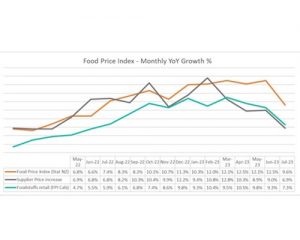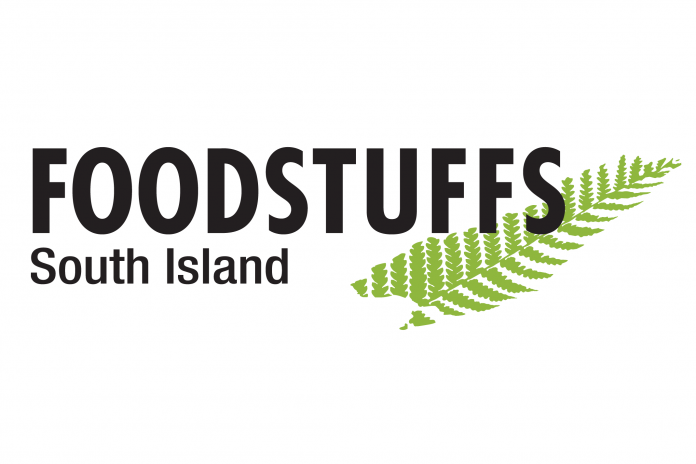 Foodstuffs analysis against FPI data (May 2022 – July 2023).
Foodstuffs analysis against FPI data (May 2022 – July 2023).
The numbers:
- Stats NZ’s Food Price Index (FPI) shows food prices on their basket measure increased 9.6%pa in July 2023, year-on-year, down from 12.5%pa in June.
- Foodstuffs data on the same product categories measured in the FPI basket shows retail prices rose 7.3%pa in July 2023 (vs. 9.3%pa in June), while the average cost increase from suppliers rose 6.9%pa (vs 9.0%pa in June).
- The Infometrics-Foodstuffs New Zealand Grocery Supplier Cost Index showed costs from suppliers to supermarkets across the wider set of 60,000 products rose 7.5%pa in July 2023 (vs. 8.3%pa in June).
- Foodstuffs New Zealand’s quarterly Customer Insights Survey finds fewer shoppers expect their financial position to worsen over the coming year, and fewer see inflation as a main concern.
“Although we’re still operating in a challenging market, with multiple factors driving inflation, July was the third month in a row that price increases in our stores on the same product categories measured in the FPI basket were slower than the month before, after the peak in April,” says Foodstuffs NZ Managing Director, Chris Quin.
Commenting on the latest food price inflation figures released by Stats NZ, Mr Quin says while food price inflation is still too high, it’s encouraging to see cost and price pressures moderating.
“It takes time, usually months but often years, for shocks and shortages to work their way through the supply chain and have an impact on shelf prices, and that’s what we’ve been seeing over the past two years.”
According to Stats NZ’s latest monthly Food Price Index (FPI), food prices were up 9.6%pa in July 2023 compared to the same time last year while Foodstuffs’ retail price increases for the same product categories measured in the FPI basket rose an average 7.3%pa.
“The annual rate of price increases has returned to where we were almost a year ago,” Mr Quin said.
Raw materials, freight and staffing remain the largest contributors to supplier cost increases, Quin says, with the co-operatives working hard to make sure customers can find value on core products.
“We’re still facing a significant volume of cost increases from suppliers, but the level of the increases fell this month, which is encouraging.”
Leafy greens continue to face challenges due to this year’s wet weather, meaning prices will likely stay higher into the foreseeable future. Foodstuffs data shows the biggest year-on-year increases were for orange kumara (up 185%pa), brown onions (up 45%pa) and bananas (up 15%pa).
Green vegetables like broccoli and leeks had been in good supply in July, and therefore offered customers the best value. Year-on-year, the biggest price decreases were for avocados (down 42%pa), tomatoes (down 24%pa) and cabbage (down 19%pa).
Looking ahead, Mr Quin says customers should see further reductions in pricing on covered crops such as capsicums, tomatoes and cucumbers as light levels increase and warmer weather settles in.
The release of the latest FPI figures follows the release of the Infometrics-Foodstuffs New Zealand Grocery Supplier Cost Index, which showed suppliers raised the cost of more than 6,500 goods in July – the highest monthly total since February. In particular, offshore increases in the cost of rice, cocoa and sugar all impacted local prices during the month.
However, the index also showed annual cost increases were trending down, with July being the fifth month in a row they had moderated – albeit still at a pace that well-exceeds pre-pandemic levels.
Mr Quin says, “New Zealand can’t escape the fact that the globalised nature of modern commerce means any major shifts in offshore supply and demand, or price rises in raw ingredients, materials or transport costs, will ultimately have an impact on what we pay at the checkout.
“That said, Foodstuffs will keep doing what we can to keep prices down – buying well, partnering with suppliers, and running our businesses as efficiently as possible. All so we can help beat inflation.
“The downward trend we’re seeing in costs and prices comes as our customers’ financial pessimism shows signs of easing slightly too, according to our latest quarterly Customer Insights Survey,” he said.
Foodstuffs’ online survey of more than 1500 customers in July found 59% expected their financial position to improve or stay the same over the coming year (up from 50% in April), including 25% who expected things to improve (up from 21%). Conversely, 41% expected their position to worsen (down from 50%).
Fewer customers named inflation as one of their main concerns, too, at 23% (down from 30% in April), although the cost of food and groceries was still their top concern, at 72% (down from 75% in April).
Most of those surveyed viewed higher petrol prices, higher shipping and freight costs, and the increase in the cost of goods from suppliers as the major contributors to increasing food prices.
Mr Quin says the two Foodstuffs co-operatives (North Island and South Island) are keeping a close eye on customer sentiment and responding accordingly.
“The current inflationary environment is affecting our customers’ spending habits. They’re cutting back on non-essential items, switching to private label brands like Pams and Value, and buying more frozen goods, less alcohol and less meat,” he said.
“It’s positive that we’re starting to see signs that customer sentiment and inflation figures are beginning to turn a corner, but both have a long way to go before we return to normal.
“With weather still the wild card here in New Zealand, everyone across the industry is hopeful growers will have some respite as we head into Spring, to boost supply and ease the cost of fresh fruit and veggies, which have been a big contributor to food price inflation.”

